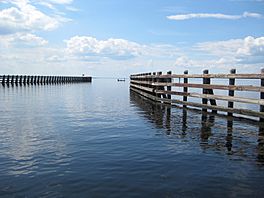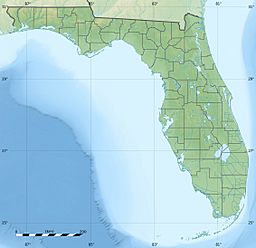Lake George (Florida) facts for kids
Quick facts for kids Lake George |
|
|---|---|

St. Johns River channel entering Lake George from the south.
|
|
| Location | Volusia / Putnam counties, Florida, United States |
| Coordinates | 29°17′12″N 81°35′53″W / 29.28667°N 81.59806°W |
| Primary inflows | St. Johns River Juniper Creek Salt Creek Silver Glen Springs |
| Primary outflows | St. Johns River |
| Basin countries | United States |
| Max. length | 11 mi (18 km) |
| Max. width | 6 mi (9.7 km) |
| Surface area | 46,000 acres (19,000 ha) |
| Average depth | 8 ft (2.4 m) |
| Islands | Drayton Island Hog Island |
| Settlements | Astor, Florida Georgetown, Florida Salt Springs, Florida Pierson, Florida Volusia, Florida |
Lake George, also known as Lake Welaka, is a large, shallow lake in Florida, USA. It is part of the St. Johns River system. The water in Lake George is a mix of fresh and salty water, which scientists call "brackish." This makes it a unique home for many different kinds of plants and animals.
Contents
Exploring Lake George's Location
Lake George is found in central Florida. The St. Johns River flows into the lake from the south. It then flows out of the lake at the north end. This northern exit point is called Rocky Point.
Lake George's Size
Lake George is the second largest lake in all of Florida. Only Lake Okeechobee is bigger. Lake George is about 11 miles (18 km) long and 6 miles (10 km) wide. It covers a huge area of about 46,000 acres (186 square kilometers). Even though it's very wide, it's quite shallow, usually only about 8 feet (2.4 meters) deep.
The History of Lake George
The name "Welaka" comes from the Muskogee language of the Seminole people. It means "chain of lakes," which describes the St. Johns River well.
Early Explorers and Names
The first European to visit this lake was Pedro Menéndez de Avilés. He was the Spanish governor of Florida. He explored the St. Johns River in the spring of 1596.
Later, the land of Florida was sold to Britain. In 1765, a royal botanist named John Bartram explored the St. Johns River. He worked for King George III. It was John Bartram who decided to name the lake "Lake George" to honor his king.
Military Use of the Lake
In more recent times, Lake George has been used by the United States Armed Forces. It has been a training area for bombing and aerial mining. This range is connected to the U.S. Navy's Pinecastle Bombing Range. That range is located in the Ocala National Forest, just west of Lake George.
These training areas started during World War II. The Navy built targets in Lake George and nearby Crescent Lake. They also had people stationed there to take care of the targets. These teams also helped with search and rescue if pilots had problems. Today, the Naval Air Station Jacksonville manages this training area.
Wildlife in Lake George
Lake George is home to many different animals. You can find migratory water birds and alligators here. What's really interesting is that you can also find animals that usually live in the ocean.
Unique Marine Life
The lake has special springs that add a bit of salt to the water. This makes the lake a good place for both freshwater and saltwater creatures. You might see Atlantic stingrays, different kinds of mullet, and striped bass.
One of the most amazing animals found here is the blue crab. There are so many blue crabs in Lake George that people can fish for them. This makes it one of the only places in the world where you can catch blue crabs in freshwater!




